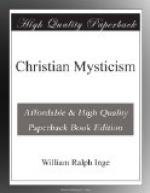[Footnote 68: Henry More brings this charge against the Quakers. There are, he says, many good and wholesome things in their teaching, but they mingle with them a “slighting of the history of Christ, and making a mere allegory of it—tending to the utter overthrow of that warrantable, though more external frame of Christianity, which Scripture itself points out to us” (Mastix, his letter to a Friend, p. 306).]
[Footnote 69: E.g. Strauss and Grau, quoted in Lilienfeld’s Thoughts on the Social Science of the Future.]
[Footnote 70: The intense moral dualism of St. John has been felt by many as a discordant note; and though it is not closely connected with his Mysticism, a few words should perhaps be added about it. It has been thought strange that the Logos, who is the life of all things that are, should have to invade His own kingdom to rescue it from its de facto ruler, the Prince of darkness; and stranger yet, that the bulk of mankind should seemingly be “children of the devil,” born of the flesh, and incapable of salvation. The difficulty exists, but it has been exaggerated. St. John does not touch either the metaphysical problem of the origin of evil, or predestination in the Calvinistic sense. The vivid contrasts of light and shade in his picture express his judgment on the tragic fate of the Jewish people, The Gospel is not a polemical treatise, but it bears traces of recent conflicts. St. John wishes to show that the rejection of Christ by the Jews was morally inevitable; that their blindness and their ruin followed naturally from their characters and principles. Looking back on the memories of a long life, he desires to trace the operation of uniform laws in dividing the wheat of humanity from the chaff. He is content to observe how [Greek: ethos anthropo daimon], without speculating on the reason why characters differ. In offering these remarks, I am assuming, what seems to me quite certain, that St. John selected from our Lord’s discourses those which suited his particular object, and that in the setting and arrangement he allowed himself a certain amount of liberty.]
[Footnote 71: Gal. i. 12.]
[Footnote 72: 1 Cor. xv. shows that he subsequently satisfied himself of the truth of the other Christophanies.]
[Footnote 73: Gal, i. 15, 16.]
[Footnote 74: 1 Cor. i. and ii.]
[Footnote 75: Chrysostom in I Cor., Hom. vii. 2.]
[Footnote 76: See Lightfoot on Col. i. 26.]
[Footnote 77: Eph. iii. 9.]
[Footnote 78: 2 Tim. i. 10 ([Greek: photizein]); cf. Eph. i. 9.]
[Footnote 79: 2 Cor. vii. 1.]
[Footnote 80: In spite of this, he is attacked for this passage in the Pseudo-Clementine Homilies (xvii. 19), where “Simon Magus” is asked, “Can anyone be made wise to teach through a vision?”]
[Footnote 81: Compare a beautiful passage in R.L. Nettleship’s Remains: “To live is to die into something more perfect.... God can only make His work to be truly His work, by eternally dying, sacrificing what is dearest to Him.”]




